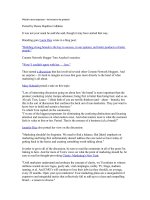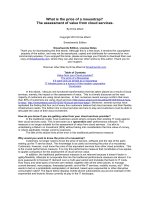Strategy - what is strategy?
Bạn đang xem bản rút gọn của tài liệu. Xem và tải ngay bản đầy đủ của tài liệu tại đây (15.78 KB, 5 trang )
Strategy - what is strategy?
Overall Definition:
Johnson and Scholes (Exploring Corporate Strategy) define strategy as
follows:
"Strategy is the direction and scope of an organisation over the long-term:
which achieves advantage for the organisation through its configuration of
resources within a challenging environment, to meet the needs of markets and to
fulfil stakeholder expectations".
In other words, strategy is about:
* Where is the business trying to get to in the long-term (direction)
* Which markets should a business compete in and what kind of activities
are involved in such markets? (markets; scope)
* How can the business perform better than the competition in those
markets? (advantage)?
* What resources (skills, assets, finance, relationships, technical
competence, facilities) are required in order to be able to compete? (resources)?
* What external, environmental factors affect the businesses' ability to
compete? (environment)?
* What are the values and expectations of those who have power in and
around the business? (stakeholders)
Strategy at Different Levels of a Business
Strategies exist at several levels in any organisation - ranging from the
overall business (or group of businesses) through to individuals working in it.
Corporate Strategy - is concerned with the overall purpose and scope of the
business to meet stakeholder expectations. This is a crucial level since it is heavily
influenced by investors in the business and acts to guide strategic decision-making
throughout the business. Corporate strategy is often stated explicitly in a "mission
statement".
Business Unit Strategy - is concerned more with how a business competes
successfully in a particular market. It concerns strategic decisions about choice of
products, meeting needs of customers, gaining advantage over competitors,
exploiting or creating new opportunities etc.
Operational Strategy - is concerned with how each part of the business is
organised to deliver the corporate and business-unit level strategic direction.
Operational strategy therefore focuses on issues of resources, processes, people
etc.
How Strategy is Managed - Strategic Management
In its broadest sense, strategic management is about taking "strategic
decisions" - decisions that answer the questions above.
In practice, a thorough strategic management process has three main
components, shown in the figure below:
Strategic Analysis
This is all about the analysing the strength of businesses' position and
understanding the important external factors that may influence that position. The
process of Strategic Analysis can be assisted by a number of tools, including:
PEST Analysis - a technique for understanding the "environment" in which
a business operates
Scenario Planning - a technique that builds various plausible views of
possible futures for a business
Five Forces Analysis - a technique for identifying the forces which affect
the level of competition in an industry
Market Segmentation - a technique which seeks to identify similarities and
differences between groups of customers or users
Directional Policy Matrix - a technique which summarises the competitive
strength of a businesses operations in specific markets
Competitor Analysis - a wide range of techniques and analysis that seeks to
summarise a businesses' overall competitive position
Critical Success Factor Analysis - a technique to identify those areas in
which a business must outperform the competition in order to succeed
SWOT Analysis - a useful summary technique for summarising the key
issues arising from an assessment of a businesses "internal" position and
"external" environmental influences.
Strategic Choice
This process involves understanding the nature of stakeholder expectations
(the "ground rules"), identifying strategic options, and then evaluating and
selecting strategic options.
Strategy Implementation
Often the hardest part. When a strategy has been analysed and selected, the
task is then to translate it into organisational action.









